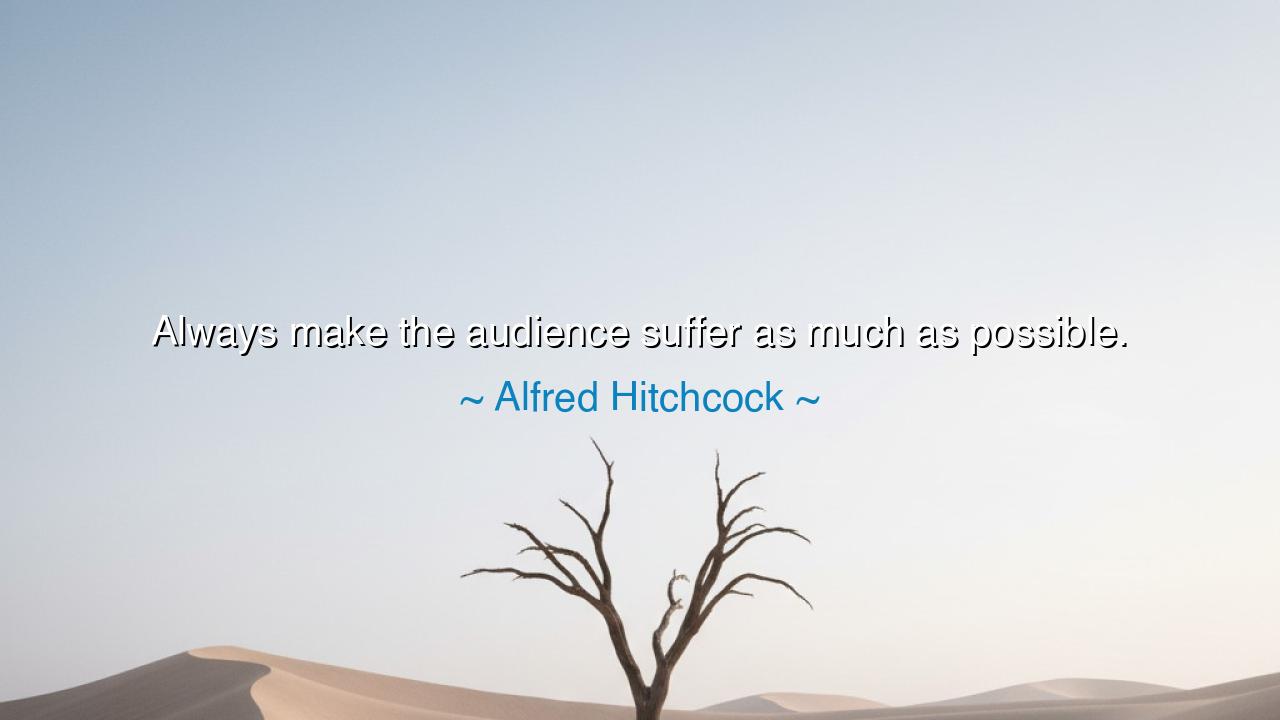
Always make the audience suffer as much as possible.






Hear the fierce words of Alfred Hitchcock, master of suspense and architect of fear: “Always make the audience suffer as much as possible.” At first, these words seem cruel, even merciless. But hidden within them lies a deeper truth—that to truly move the hearts of men, one must stir them to their very core. For it is not comfort that awakens the soul, but tension, dread, longing, and release. Hitchcock knew that the suffering of the audience was not torment for its own sake, but the crucible through which emotion is purified into awe.
From the beginning of storytelling, this has been the way of great art. The Greek tragedians did not shield their people from sorrow; they placed Oedipus before them, blind and broken, so that all might share in his agony and thus feel catharsis. Shakespeare did not spare his audience when he showed them the dagger in Macbeth’s hand or the lifeless form of Juliet. To make the audience suffer is to make them live, to awaken their blood and bone to the reality of fear, pity, and love. Without this, art is but a shadow, a pale comfort with no lasting mark upon the heart.
Hitchcock was the modern heir to this ancient truth. In Psycho, he placed the audience in a position of dread, letting them witness a shower turned into a slaughter, and afterward left them in the grip of paranoia. In Rear Window, he gave them the slow torture of knowing there was danger across the courtyard, but not knowing when it would strike. His genius lay not in cruelty, but in suspense, the careful tightening of the rope until every heart in the theater beat with the same anxious rhythm. The suffering he crafted was shared, and in that shared torment came a collective experience, unforgettable and profound.
Consider too the tale of ancient Rome, where gladiatorial games once enthralled the masses. Though brutal, they revealed the same principle: the crowd longed to feel, to be carried to the edge of horror, to experience fear safely and yet completely. What Hitchcock did with shadows and music was but the civilized echo of what humanity has always sought—to be shaken, to confront the abyss, and to emerge trembling but alive. He understood that true engagement comes when the audience is not spared, but tested.
And yet, O listener, there is wisdom for life here as well. For in your own days, you will find that the most powerful lessons come not from ease but from trial. Just as the audience suffers in the hands of a master to awaken their deepest emotions, so too do men and women grow by passing through the furnaces of despair, fear, and longing. It is in tension that character is revealed, in difficulty that virtue is proven. What Hitchcock did with cinema, life itself does with the human soul.
The lesson then is clear: do not shrink from suffering, whether on the screen or in your own journey. For the ache of suspense, the torment of uncertainty, the dread of the unknown—these are not punishments, but teachers. They draw out endurance, they deepen compassion, they awaken appreciation for peace when it finally arrives. If the audience in the theater must suffer to taste the sweetness of release, so must you endure hardship to taste the fullness of life.
Therefore, O traveler, honor Hitchcock’s paradox. When you create, do not be afraid to challenge others, to make them think, to make them tremble, to make them suffer for the sake of truth. And when you live, do not curse the trials that tighten the rope around your heart, for they are shaping in you the strength that comfort never could.
So remember: to suffer is not to be destroyed, but to be transformed. As Hitchcock commanded his art, so let your life command you—to embrace the fire, to endure the suspense, and to find within suffering the very pulse of existence.






AAdministratorAdministrator
Welcome, honored guests. Please leave a comment, we will respond soon